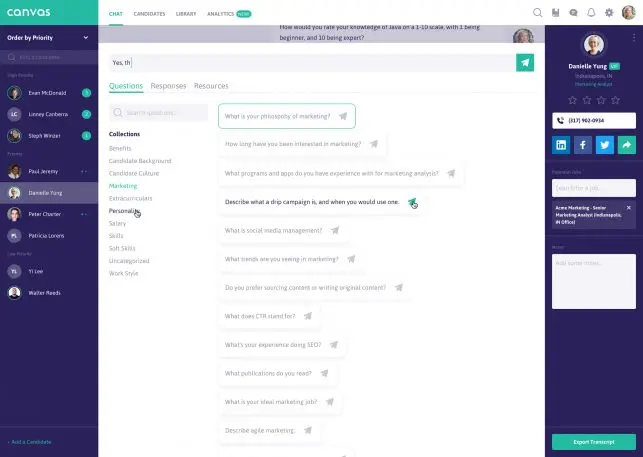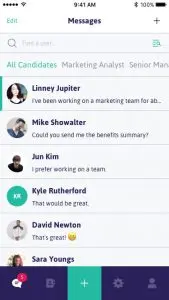The other day I got a text from Clara Banks, suggesting we get to know each other better. She wasn’t looking for a date. Banks is a recruiter at a startup called Barksy. She sent me a link so I could learn more.
Clicking the bit.ly link took me to a short video that walked me through how Barksy is using a platform called Canvas to text with potential job applicants. The 60-second video showed a young woman getting texts from a recruiter while she was commuting, at a cafe, or at the gym. Their conversation was the basic stuff of initial screening interviews like “tell me about your experience” and gave the candidate an opportunity to ask questions, too. By the end, the recruiter was asking to set up a phone interview.
When I was done watching the video, Banks texted again: “Can you tell me a little bit more about yourself?” Because I’ve written about the use of artificial intelligence like chatbots in recruiting, I immediately thought I’d try to to see if I was dealing with a real person. I texted back: “I’m allergic to dogs. Can you tell me what your benefits are like?” Banks responded with another link that led to a short synopsis of the company’s benefits package.
At this point, Banks could have kept me texting, but the human at the other end of the mobile wasn’t actually her. It was Aman Brar, CEO of Canvas, and the purpose of this particular conversation was to illustrate how texting enables recruiters to screen more job candidates and market employers’ brands. The platform officially launches today, although real companies have been using it for months. One of these early adopters is a recruiting agency who reported that the speed and agility of texting is key. Brar says they’ve been able to screen 10 times more candidates daily with the platform.
The way it works in real life is pretty similar to what I experienced. The difference is that if I were an actual candidate applying to a company (Barksy is fictitious, too) the recruiter could have taken me through a portfolio of interview questions via text. I would also have had the opportunity to ask more detailed questions about the company, the job responsibilities, work hours, etc. The recruiter can use the desktop or the Canvas mobile app version—available on iOS and Android—to facilitate the interviews.

Canvas has another time-saving feature in that the transcript of the text conversations can be sent to hiring managers in their entirety, or they can be summarized. Brar showed me how the recruiter can give a thumbs up or down to individual answers and the platform provides an overall score for the candidate. Recruiters can choose to share the scores or not; it’s up to them.
But Canvas isn’t just built for speed. Brar notes that reaching candidates by text could solve the larger problem of getting someone–either the candidate or the recruiter–to respond at all. The hiring process now takes longer than ever, according to Glassdoor, and half of applicants surveyed by Talent Board said they never heard back at all after submitting their resumes. A recent survey from Yello suggests that employers are going about contacts with job seekers all wrong. Out of the more than 1,400 adults under 30 surveyed, 86% reported feeling positive about getting text messages during the interview period. Couple this with the fact that Nielsen found that texting is the most used data service in the world with an estimated 18.7 billion texts sent worldwide every day (not including app to app).
Although Brar cites the staggering number of millennials who will make up the workforce by 2025 he says it’s not only digital natives who will readily respond to recruiters’ texts. “I would have never guessed a recruiter in the manufacturing space would be our first client,” he says. He also notes that Canvas signed a larger health care organization that’s hiring a lot of nurses. “These are people who are hard to get to during the day,” he says, as some work second or third shift. Texting, he maintains, “is a lighter ask than, ‘hey can we have a phone call?'”
As for getting those mobile numbers from candidates, most resumes include them. As for passive candidates who aren’t actively seeking a job, but might be persuaded if the right offer comes along, Brar says, “Recruiters are sourcing by the same methods they traditionally have,’ like college campuses, job fairs, etc. “Once they are ready to engage they get the mobile numbers,” he explains, “It’s very authentic and organic. We don’t impact the sourcing.”


“Recruiters making 30-50 outbound connect with 5 [people],” he says, which works out to about 10%. This particular client had a response rate of 50% for this client. “Imagine if the only option to connect was through voice calls,” he says. It would be impossible to get the same kind of scale, especially considering that some positions garner hundreds of applicants. Fast Company recently reported how one man applied to 538 jobs over about a three-month period.
The most surprising thing that’s surfaced from early adopters using the platform is the level of professionalism the candidates have shown. Texting means different things to different people, so potential for the recruiter to receive a message that doesn’t use proper grammar and punctuation is high.
One vice president of HR reportedly asked Brar what to do if they send an emoji or spell you as “u” instead of typing out the whole word.
Ultimately, says Brar, “You are in a tight labor market and if the worst thing that happened is your candidate treated you like a friend, I don’t think that’s a bad thing.” He says the CEO of that company agreed. He does contend that Canvas texting is just one way to understand a person and help them get to the next level. “You wouldn’t marry someone after just a text interaction,” he quips. “We want to support human to human interaction.”
Recognize your brand’s excellence by applying to this year’s Brands That Matter Awards before the early-rate deadline, May 3.
